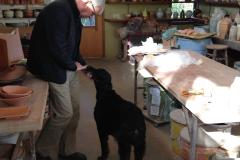Inside the Box
I acquired my first electric kiln about thirty years ago. It had three switches, each with three settings, and a cone sitter - simple. I didn't trust the cone sitter but given all the other things in life that couldn't be trusted, the sitter's erratic behavior barely mattered. I imagine there isn't really that much to say about electric firing. There was a time when electric kilns were on the cutting edge of technology, but it was likely a frontier shared with clothes dryers and toasters. While their beginnings may have been a little mysterious, they were never very demanding. And besides, what I really wanted was a salt kiln, one that I would build with my own hands and that fired with wood and oil.
I was living in the country, setting up a studio and learning how to begin. I had begun to develop a theory that salt firings, especially the long difficult ones, were a provisional hedge against aesthetic failure, and an investment in character. My experience with atmospheric firing had been brief but seductive. I wanted a stockpile of wood and a big fire: to smell smoke, to unpack it too hot, and then marvel at the capricious color and rich finished surfaces. In retrospect, it was an effort to understand how kilns and firing from other times and places might help me locate myself. Like others who had begun a similar quest, I was in pursuit of something authentic. I was interested in becoming an author who practiced as a professional at the work of making pottery, and against serious odds, pottery that was authentic - somehow original, neither conterfeit nor copied. The apparently endless variations imbedded in atmospheric firing seemed like a place to begin this work.
But in the meantime, I had discovered a used electric kiln; it was cheap and I bought it. I had work that needed to be fired. I used it for several months, puttered with lead glazes-trying to emulate those I had seen in the Royal Ontario Museum - and a local earthenware clay. Though I didn't know it at the time, it was the beginning of a seditious and ongoing investigation. I remain romanced by lead's charms and its clear, luscious, and honeyed charactera metaphor for both beauty and danger.
When compared to the challenges of firing a wood kiln, I suspected electric kilns were made for less inventive and rigorous work. Moreover, when compared to the textured collection of brick and steel kilns that I had come to know as a student, electric kilns were just not very interesting objects. It was a curious perspective that has mostly passed; but I still feel that developing a fellowship with electric kilns, like other appliances, represents a difficult intellectual and spiritual challenge. They don't take a village to fire or build; they don't breathe fire; they don't advocate for surface; and after the cones have fallen and it's over, unlike a wood firing or good sex, it's not very satisfying. Imagine the deep night, crisp and clear: the cone sitter's solitary click, like a cheap nail on cold concrete, signaling the firing's arduous end. Now, in the company of good scotch and a smoke, ifs time to relive the rigors of the firing...not likely.
It may be unique to ceramics that method and meaning can be understood as mutable co-conspirators. Within this scheme, the finished object documents conceptual beginnings and intended meaning. The serendipity of process and circumstance also informs meaning and contributes to identity. Even the uneventful electric kiln leaves an indelible imprint, a thin memory of time and place, and in its wake subtle provocations of transformation and moments frozen.
It's been twelve years since I seriously began to reconsider color, firing, and electricity. I left salt and wood reluctantly for chromatic reasons, knowing full well that firing would never be the same, and it isn't. But I was wrong to think that electricity would be more predictable; the kiln continues to meddle with its assigned role. If form is orchestrated on one side of the box, while surface, color, texture, and timbre are secured unseen on the other side, then the box in all its variations, beautiful and ugly, demanding and indifferent, may be understood as an instrument of transformation.
Whatever their variations, kilns are like instruments, hopefully chosen for their responsive capacity to conduct and capture meaning.

